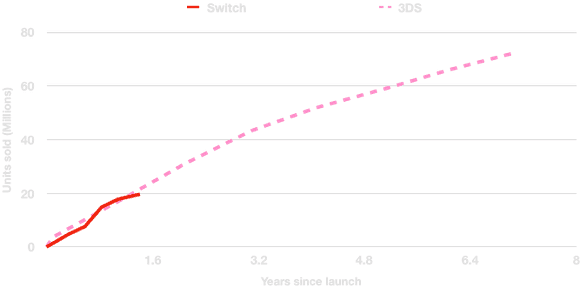There are too many video games. What now?
Excerpts from Steven Wright’s Polygon Cover Story, emphasis my own:
“Everyone can make games, but be realistic. … It used to be that you could do something that nobody had ever seen before, or you could do something familiar really well. Now, it has to be innovative and have incredible quality.”
Games are surely easier to make than ever before. Easy for me to say as I’ve never made a game, but I have to believe that today’s technology has decreased the barrier of entry to development. That’s not to say it’s easy to create a good game. Like any good art or media, that is an incredibly difficult feat.
The tech to create games is more accessible than ever. Formal eduction to learn how to make games has become readily available. The distribution of games becomes increasingly easy via tools like Epic’s Unreal Engine which allows developers to “more easily ship games and seamlessly optimize gameplay across platforms.”
For those developers creating online experiences, the choice and complexity of platform to develop for and release to shrinks ever more with cross-platform play becoming increasingly popular.
It begs the question there is inevitably one experience everywhere, how do the plethora of games become seen? I believe indies will come to depend on large publishers for marketing budgets to cut through the cruft. But those publishers will be increasingly looking for guarantees on their investments. Not a chance on a new indie title.
When Finnish studio Housemarque released a twin-stick shooter called Nex Machina into the wilds of Steam in 2017, it didn’t exactly expect the game to to set tills alight. Even with those lowered expectations, however, the team behind the acclaimed defend-’em-up Resogun found itself shocked at the lack of impact that the Housemarque name seemed to have on the droves of consumers scrolling through Steam every day. When the sales numbers finally trickled t in — Housemarque declined to discuss specifics for this story, but SteamSpy and this recently patched achievement leak puts the number slightly below 100,000 copies sold as of summer 2018 — the mood was somber, with the studio’s head of publishing, Mikael Haveri, describing it as “devastating.”
The past few games I’ve played (and enjoyed!) on iOS have been published by Annapurna Interactive. The brand has made its impression. I couldn’t tell you the developer of any of these games.
The frequency at which a publisher for multiple developers can get its brand in front of the player is far greater than any indie developer. Recognition by saturation.
If the publisher is able to consistently publish top-notch experiences, they also become a trusted curator of which players will seek new titles.
If a developer seeks to have the same level of recognition, they are absolutely required to create something “innovative and of incredible quality” to compel a player to invest in their complete experience, thus building a relationship. The longer the experience lasts, the deeper the relationship becomes.
Blizzard and Epic have created addictive experiences that continue pull players back in over and over, again and again, for hours on end; drilling their brand in with each launch of the game as well as their proprietary launchers and stores.
Nintendo iterates on familiar and successful franchises to deepen the association of a particular IP to Nintendo, thus deepening the player’s relationship with and trust in Nintendo. Should a new Nintendo IP comes along, chances are those with a relationship with Nintendo will give it a try. And because Nintendo consistently creates stellar experience, the trust will likely grow.
Capybara Games released an innovative title of incredible quality for iOS in Superbrothers: Sword & Sworcery days after the iPad 2 was released — arguably the first experience of its kind. The title was of novel design, mysterious, tonally unique, integrated social sharing to encourage peer-to-peer marketing, and was immersive and long enough to draw players back in through to completion during the early days of a platform. While Capybara may not be a household name, their design and tone is now familiar.
All of this said, the chances of a developer becoming a household name are far slimmer than a publisher who’s essentially become a curator. The same could be send for indie record labels and film distribution/production houses.
Devolver’s Nigel Lowry says that although many industry veterans and gamers alike think of the gaming market as a finite amount of money that hungry consumers are willing to spend in a given time period — say, this bloody holiday season, which is particularly awash with high-profile franchises that must duke it out, such as Assassin’s Creed and Red Dead Redemption — in the past few years, it’s become apparent that the limiting factor isn’t measured in dollars, but hours. In a climate where every game is stuffed to the gills with five tiers of colored loot, massive open worlds, reams of optional content and a dozen content patches lurking on the schedule before the core package even hits store shelves, it seems that game developers are battering each other harder than ever before to compete for the attention of games worldwide.
“Even if the most hardcore gamer plays 14 hours a day, that’s still a finite amount of time,” he says. “And if you’re spending 10 of those in a PUBG, or a Fortnite, what does that leave for the rest of us? It’s true that timing of release is critical, sure, and I don’t think that single-player, smaller-scope games are going to go away; there’s always going to be room for that. But time is something that you really can’t move, and you have to account for that when people move into these long-term relationships with games.
See Self-competing and Time Blocking.
I truly don’t know what the future of indies is, but it doesn’t look great.

